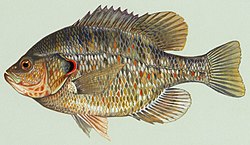Top Qs
Timeline
Chat
Perspective
Valentine Formation
Geological formation in midwestern US From Wikipedia, the free encyclopedia
Remove ads
The Valentine Formation is a geologic unit formation or member within the Ogallala unit in northcentral Nebraska near the South Dakota border. It preserves fossils dating to the Miocene epoch of the Neogene period and is particularly noted for Canid fossils.[2][3] This unit consists of loosely consolidated sandstone that crumbles easily. These sands carry the water of the Ogallala Aquifer and is the source of much of the water in the Niobrara River.[1] A particular feature of the Valentine is lenticular beds of green-gray opaline sandstone that can be identified in other states, including South Dakota, Nebraska, Kansas, and Colorado. Although three mammalian fauna stages can be mapped throughout the range of the Ogallala, no beddings of the Ogallala are mappable and all attempts of formally applying the Valentine name to any mappable lithology beyond the type location have been abandoned. Even so, opaline sandstone[4] has been used to refer to this green-gray opalized conglomerate sandstone that is widely found in the lower Ogallala Formation.
Remove ads
Development, the earliest Ogallala deposits
At the beginning of the Ogallala times, as sediments began washing out from the rising Rocky Mountains into the central plains states, the members of the Pierre Shale[5] and Niobrara Formation outcrop had been largely exposed in their present outcrop range. The Niobrara had been broadly incised by the present river systems, but only to a fraction of their present depths. Therefore, the earliest Ogallala deposits, the time of the Valentine deposits, filled in these shallower valleys; but there was no continuous exposure over the range of the eastern outcrop of the Ogallala.[6][4] Isolated exposures of the Valentine phase have been located along the Niobrara outcrop and quarried along the Smoky Hill River, Solomon River, Republican River, and Niobrara River where these watersheds have cut deeply down through the Niobrara Chalk into the Carlile Shale.
Remove ads
Lithology
The Valentine Formation presents white, buff, gray to gray-green, unconsolidated, fine-to-coarse grained, fluvial siltstone, channel sandstone, and gravel eroded from uplift of the Rocky Mountains as well as locally eroded materials,[7] particularly Niobrara chalk cobbles and chalk sand.[8] Thin, localized beds of caliche are abundant. A specific index stone for the Valentine is the lenticular beds of grey-green opaline sandstone. Locally thick beds of volcanic ash are associated with the underlying opaline sandstone
Remove ads
Distribution
Even as discussed above, the term Valentine is not now formally used outside of Northcentral Nebraska, older literature in other states with Ogallala may refer to the name.
The opaline sandstone of the lower Ogallala is recognized in Kansas in outcrops on hills to the east of the limits of the upper Ogallala (e.g., Rush, Graham, and Rooks counties). These outcrops, which formed in the bottoms of shallow valleys, are now found on the upper slopes of deeper valleys; that is, in inverted topographies.[9][10]
The Ogallala's opaline sandstone is to be found in Arkansas River gravel at Pueblo, Colorado.[11]
Uses
The silicate cementation makes the opaline sandstone denser and harder than any other local stone, and it has been quarried as ballast, road gravel, and dam outflow rip-rap (e.g., Cedar Bluff Reservoir, Sherman Dam[12]). The opaline sandstone has had limited use in construction, and example being the structures in the city park of Hill City, Kansas. Beds of flint or chert can be found higher in the Valentine and the weathered Niobrara Chalk is also silicified where there is contact with these beds in the Valentine.
Remove ads
Fossil content
Color key
|
Notes Uncertain or tentative taxa are in small text; |
Mammals
Bats
Carnivorans
Lagomorphs
Proboscideans
Rodents
Ungulates
Birds
Reptiles
Squamates
Testudines
Amphibians
Fish
Plants
Remove ads
Gallery
- Valentine opaline sandstone with white Niobrara pebbles, Rush County, Kansas
- Valentine opaline sandstone, Hays, Kansas
- Valentine-contact opalized Niobrara, Frontier Park, Hays, Kansas
- Antelope Lake Park buildings in Graham County, Kansas
- Bogue, Kansas Township Hall
See also
References
Wikiwand - on
Seamless Wikipedia browsing. On steroids.
Remove ads




























